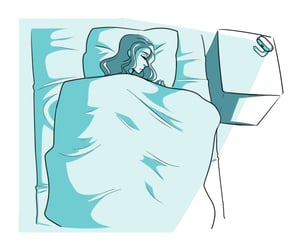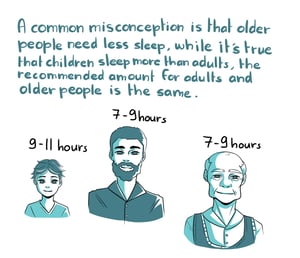A research-based explanation about what sleep is.
During sleep, your body works its way through a series of distinct stages to help you process what has happened that day, as well as to prepare for the next. This applies to both body and mind. It is important that your body is allowed to do this properly — both how much sleep it gets and the quality of sleep is vital for this task.
 Sleep was long considered just a block of time when your brain and body shut down. Thanks to sleep research studies performed over the past several decades, it is now known that sleep has distinct stages that cycle throughout the night in predictable patterns. Your brain and body functions stay active during sleep, but your organs behave differently during each sleep phase. For instance, certain stages of sleep are needed for us to feel well rested and energetic the next day, while other stages help us learn or make memories.
Sleep was long considered just a block of time when your brain and body shut down. Thanks to sleep research studies performed over the past several decades, it is now known that sleep has distinct stages that cycle throughout the night in predictable patterns. Your brain and body functions stay active during sleep, but your organs behave differently during each sleep phase. For instance, certain stages of sleep are needed for us to feel well rested and energetic the next day, while other stages help us learn or make memories.
In brief, a number of vital tasks carried out during sleep help people stay healthy and function at their best. In contrast, not getting enough sleep can be dangerous — for example, you are more likely to be involved in a car crash if you drive when you are drowsy.
 Sleep needs vary from person to person, and they change throughout your life. Most adults need 7-8 hours of sleep each night. Newborns, on the other hand, sleep between 16 and 18 hours a day, and children in preschool sleep between 11 and 12 hours a day. School-aged children and teens need at least 10 hours of sleep each night.
Sleep needs vary from person to person, and they change throughout your life. Most adults need 7-8 hours of sleep each night. Newborns, on the other hand, sleep between 16 and 18 hours a day, and children in preschool sleep between 11 and 12 hours a day. School-aged children and teens need at least 10 hours of sleep each night.
Some people believe that adults need less sleep as they get older. But there is no evidence to show that older people can get by with less sleep than younger people. As people age, however, they often get less sleep or they tend to spend less time in the deep, restful stage of sleep. Older people are also more easily awakened.
There are two basic types of sleep: rapid eye movement (REM) sleep and non-REM sleep (which is split into light and deep sleep). You cycle through all stages of non-REM and REM sleep several times during a typical night, with increasingly longer and deeper REM periods occurring toward the morning.
Sleep stages details
- Light sleep. First step from awake to falling asleep. Your body calms down and prepares for sleep. It is easy to wake up. Next, your body prepares for deep sleep by slowing further down. Typically covers 50% of your night.
- Deep Sleep. Now the body is calm, without any eye movement or muscle activity. It will repair muscles and tissue, stimulate growth and development, boost immune functions, and build up your energy for the next day. Typically covers about 25% of your night.
- REM sleep. During REM sleep, your brain is more active, and this is when you dream. Important to learning and memory, REM is when your brain processes and consolidates information from the previous day, storing it in your long term memory. Typically covers 25% of your night.
Source: National Institute of Child Health and Human Development and National Sleep Foundation
